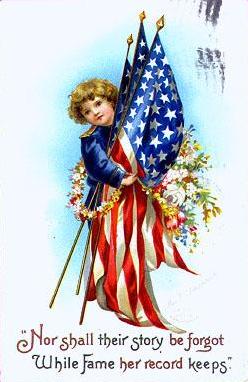Memorial Day Observances
 Memorial Day is a federal holiday observed annually in the United States on the last Monday of May. Memorial Day is a day of remembering the men and women who died while serving in the United States Armed Forces. Formerly known as Decoration Day, it originated after the American Civil War to commemorate the fallen Union soldiers of the Civil War. (Southern ladies’ organizations and southern schoolchildren had decorated Confederate graves in Richmond and other cities during the Civil War, but each region had its own date.) By the 20th century Memorial Day had been extended to honor all Americans who have died in all wars.
Memorial Day is a federal holiday observed annually in the United States on the last Monday of May. Memorial Day is a day of remembering the men and women who died while serving in the United States Armed Forces. Formerly known as Decoration Day, it originated after the American Civil War to commemorate the fallen Union soldiers of the Civil War. (Southern ladies’ organizations and southern schoolchildren had decorated Confederate graves in Richmond and other cities during the Civil War, but each region had its own date.) By the 20th century Memorial Day had been extended to honor all Americans who have died in all wars.
Originally known as Decoration Day, Professor Gardiner points to a local woman in Columbus, GA named Mary Ann Williams, who in the spring of 1866 wrote an open letter suggesting “a day be set apart annually” and become a “custom of the country” to decorate the graves of fallen soldiers with flowers.
That day, described as a national day, was chosen to be April 26, the anniversary of Gen. Joseph E. Johnston’s surrender in North Carolina to Gen. William Tecumseh Sherman of the Union Army. The letter, or a summary of it, ran in newspapers all over the South, and as far west as St. Louis and as far north as New Hampshire, leading to widespread ceremonies on that day. This was to be a day for Confederate dead only.
Columbus, Miss., was a hospital town, and in many cases a burial site, for both Union and Confederate casualties of Shiloh, brought in by the trainload. And it was in that Columbus where, at the initiation of four women who met in a 12-gabled house on North Fourth Street, a solemn procession was made to Friendship Cemetery on April 25, 1866.
As the story goes, one of the women spontaneously suggested that they decorate the graves of the Union as well as the Confederate dead, as each grave contained someone’s father, brother or son. A lawyer in Ithaca, N.Y., named Francis Miles Finch read about this reconciliatory gesture and wrote a poem about the ceremony in Columbus, “The Blue and the Gray,” which The Atlantic Monthly published in 1867.
“My view is it’s really the poem that inspired the nation,” said Rufus Ward, a retired district attorney, sitting in his basement and sipping a mint julep (his grandmother’s recipe, he said, the one she shared with Eudora Welty).
|
The custom of strewing flowers on the graves of fallen soldiers has innumerable founders, going back perhaps beyond the horizon of recorded history, perhaps as far as war itself. But there is the ancient practice and there is Memorial Day, the specific holiday, arising from an order for the annual decoration of graves that was delivered in 1868 by Maj. Gen. John A. Logan, the commander in chief of the Grand Army of the Republic, a group made up of Union veterans of the Civil War.
According to the United States Department of Veterans Affairs, roughly two dozen places claim to be the primary source of the holiday, an assertion found on plaques, on Web sites and in the dogged avowals of local historians across the country.
Yet each town seems to have different criteria: whether its ceremony was in fact the earliest to honor Civil War dead, or the first one that General Logan heard about, or the first one that conceived of a national, recurring day.
It was observed for the first time on May 30 of the same year; the date was chosen because it was not the anniversary of a battle. The date was subsequently changed to the last Monday in May by Congress in 1968, observed at the Federal level for the first time in 1971.
The date of April 26th remains a strong date of memory in the South with the continued observance of Confederate Memorial Day, shared by other dates in the Southern states. Most Southern states still observe a combination of Confederate Memorial Day, Robert E Lee’s birthday, and Jefferson Davis’ birthday.
CED Solutions is honored to offer training for the Armed Forces of the United States and is proud to provide reduced-cost training to military service members.






